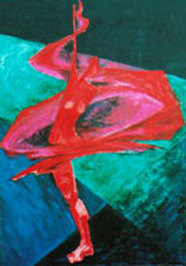PhD Thesis: The Ecological Body ~ extracts
Being in BetweenThis interactive spectacle will stimulate and enhance public perception of the dynamics and interdependence between plants, primates and humans within the Zoo. This ecological concern and ‘systems awareness’ is currently important in our work. We apply ecological principles not only to the development of environmental movement training for performers and to ways of generating devised material, but also to the aesthetics of the final product and to our methods of production. (Kershaw and Reeve, 2005)
Niche and Systems With reference to ‘niche’, the performers’ were working with an awareness of the possible transformation of autobiographical material within the context of an immersive performance. How could they be fully immersed in something and self-reflexive at the same time? This dual intention almost obliged them to remain present and involved in unpredictable circumstances. In addition, as a system, the performance was challenging the network of systems to become self-reflexive about its own contradictions: ‘to hold a mirror up to nature’. Niche and Systems Video Strata dealt more with individual process. Being in Between, was more concerned with ‘systems’ than individuals. Borders of Humility and Humiliation explored the relationship between individual process and cultural systems. Lemur and Primatologist Video It was as if the lemur ‘system’, once disrupted by the unusual approach of the performers’ improvisations, sought to absorb the new information and then dissolved, but managed to find a new order, once the new information had been integrated. The performers’ returned at the same times each day, thus integrating their dance as part of a new routine for the lemurs. The ‘different’ information for the lemur system conveyed through the performers’ unexpected behaviour created a response in the system: a ‘surprising’ performance moment emerged between humans and lemurs, when they moved in response to each other, and this level of improvisation gradually became the norm over the following days. The human system and the lemur system were paying attention to each other in a new way. Spider Monkey Dance Video Front of house staff slipped out to watch and some zookeepers appeared: word had got around that the performers and the spider monkey danced together. As people perceived the indisputable relationship between the humans and the monkey through movement, and witnessed the change of role as the humans danced for the monkey, attitudes changed. The dance began to make sense in a different way and comments changed from: ‘Oh look! they are pretending to be monkeys’, to: ‘Oh look! they are dancing with the monkey!’ In those moments, awareness and meaning shifted for the audience, stimulated by the ‘incorporated‘ movement of the performers. In my own notes, I wrote: "All my senses came to life: I could suddenly hear the sound of the wind in theleaves of the large beech tree, see the expression of delighted amazement on my father’s face, and feel the sadness in the stances of the performers as they turned away from the monkey for the last time. I felt present and alert to the moment." Reflection on Open Systems, Transience and Emergence. In Being in Between, the emphasis was on ‘systems’ rather than ‘individuals’: how to create the optimum conditions for the emergence of an embodied, dynamic performance system which would be integrated within the fabric of the zoo, but which could also disrupt the other systems’ perception of themselves within the culture of the zoo. The site consisted of a mixture of architecture, housing the various animals, offices, a shop and a café, botanical gardens surrounding the animal dwellings; pathways, playgrounds and ponds. From opening time until dusk, the movement through the zoo was constant and complex, and the performers were obliged to devise and perform their material in the midst of a myriad influences. It was such a symbiotic site that it was difficult to find the border between the environmental site and the systems inhabiting it. In terms of ‘emergence’, as I learnt in the ‘Gorilla House’, if I had tried to establish more control for the performers by tightening the score or imposing performance spaces, I would have done them a disservice, as their system would have become part of the ‘over-determined’ motif of the zoo, and they would have been fettered in their possible responses to the moment. As it was, the score was intended to give them confidence, inner logic and enough of a map but to allow them to improvise and enter the ‘unknown territory’ whenever they needed to. Out of such spontaneous moments, the unexpected emerged, as in their encounters with the lemurs and the spider monkey. |
Thesis pages
|
